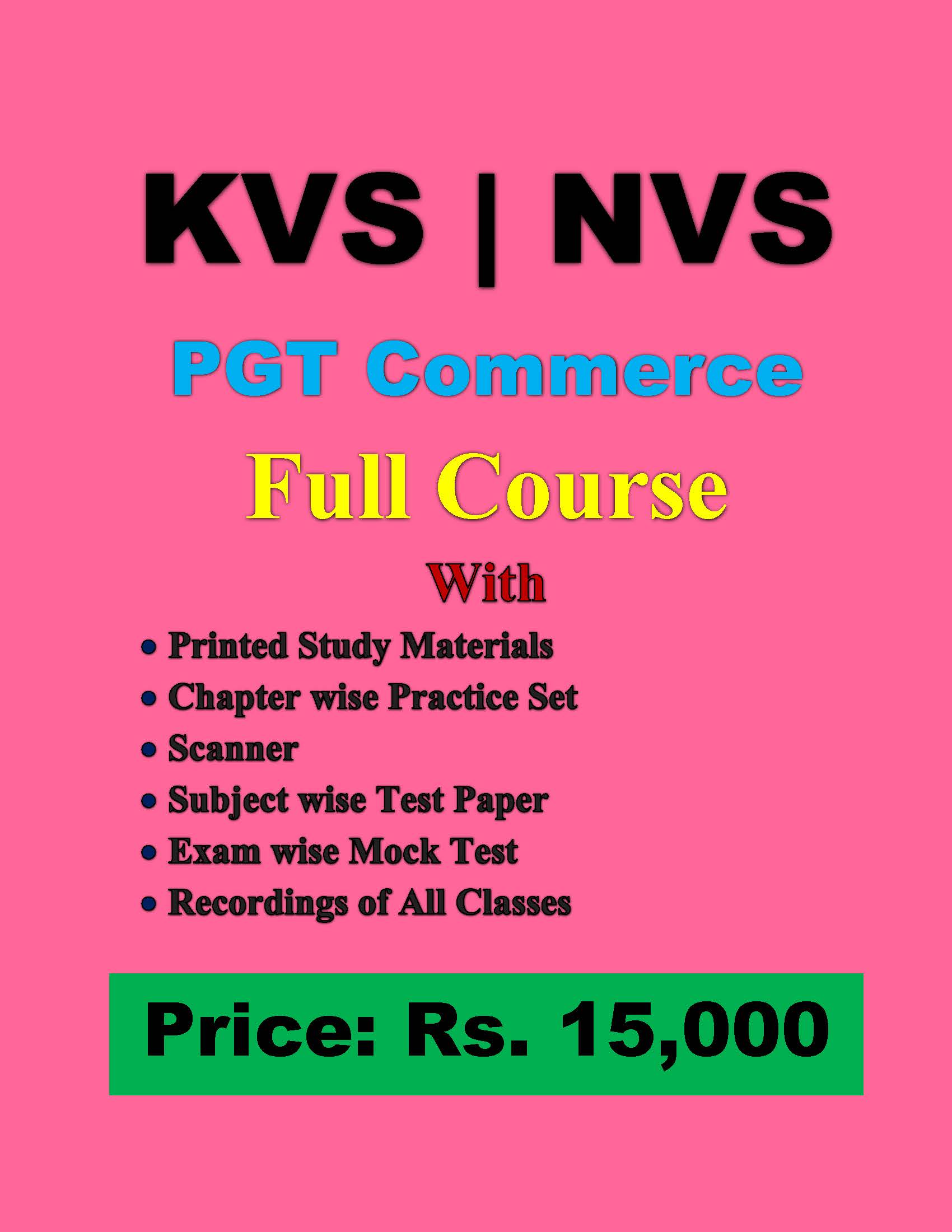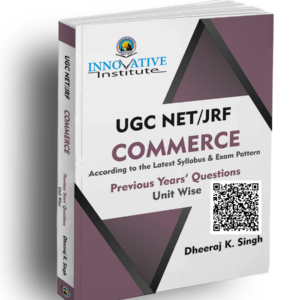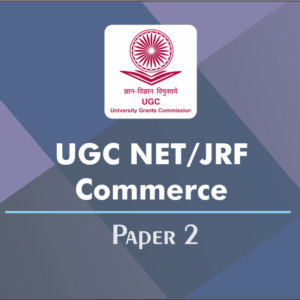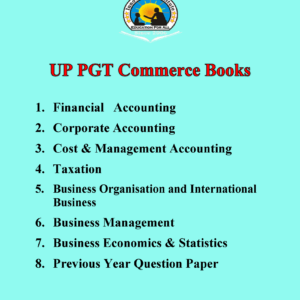Description
Unit Wise Practice Set Subject Wise Test Paper Subject Wise Scanner
Exam Wise Mock Test Previous Year Question Pattern
Syllabus for the post of PGT Commerce – Accountancy & Business Studies
A. Accountancy
Subject-specific syllabus includes the concepts of NCERT/CBSE syllabus and Text Books (Classes XI & XII), however, the questions will be testing the depth of understanding and application of these concepts at the level of Post- Graduation.
Introduction to Accounting
- Accounting- concept, meaning, as a source of information objectives, advantages and limitations, types of accounting information; users of accounting information and their needs. Qualitative Characteristics of Accounting Information. Role of Accounting in Business.
- Basic Accounting Terms- Business Transaction, entity, Capital, Drawings. Liabilities (Non Current and Current). Assets (Non Current, Current); Fixed assets (Tangible and Intangible), Expenditure (Capital and Revenue), Expense, Revenue, Income, Profit, Gain, Loss, Purchase, Sales, Goods, Stock, Debtor, Creditor, Voucher, Discount (Trade discount and Cash Discount)
Theory Base of Accounting
- Fundamental accounting assumptions: GAAP: Concept
- Business Entity, Money Measurement, Going Concern, Accounting Period, Cost Concept, Dual Aspect, Revenue Recognition, Matching, Full Disclosure, Consistency, Conservatism,
Materiality and Objectivity System of Accounting. Basis of Accounting: cash basis and accrual basis - Accounting Standards: Applicability in IndAS
- Goods and Services Tax (GST): Characteristics and Advantages.
Recording of Business Transactions
- Voucher and Transactions: Source documents and Vouchers, Preparation of Vouchers, Accounting Equation Approach: Meaning and Analysis, Rules of Debit and Credit.
- Recording of Transactions: Books of Original Entry- Journal
- Special Purpose books
- Cash Book: Simple, cash book with bank column and petty cashbook
- Purchases book
- Sales book
- Purchases return book
- Sales return book
- Journal Proper
- Ledger: Format, Posting from journal and subsidiary books, Balancing of accounts
- Bank Reconciliation Statement:
➢ Need and preparation, Bank Reconciliation, Statement with Adjusted Cash Book - Depreciation, Provisions and Reserves
➢ Depreciation: Meaning, Features, Need, Causes, factors
➢ Other similar terms: Depletion and Amortisation
➢ Methods of Depreciation: i. Straight Line Method (SLM) ii. Written Down Value Method (WDV) - Difference between SLM and WDV;
- Advantages of SLM and WDV Accounting treatment of depreciation
i. Charging to asset account
ii. Creating provision for depreciation/accumulated depreciation account
iii. Treatment for disposal of asset - Provisions and Reserves: Difference
- Types of Reserves: i. Revenue reserve ii. Capital reserve iii. General reserve iv. Specific reserve v. Secret Reserve
• Difference between capital and revenue reserve
Trial balance and Rectification of Errors
- Trial balance: objectives and meaning & preparation
- Errors: types-errors of omission, commission, principles, and compensating; their effect on Trial Balance. Detection and rectification of errors; preparation of suspense account.
Financial Accounting – II
- Financial Statements Meaning, objectives, and importance; Revenue and Capital Receipts; Revenue and Capital Expenditure;
- Deferred Revenue expenditure.
- Trading and Profit and Loss Account: Gross Profit, Operating profit and Net profit. Preparation.
- Balance Sheet: need, grouping and marshalling of assets and liabilities. Preparation.
- Adjustments in preparation of financial statements with respect to closing stock, outstanding expenses, prepaid expenses, accrued income, income received in advance, depreciation, bad debts, provision for doubtful debts, provision for discount on debtors, Abnormal loss, Goods taken for personal use/staff welfare, interest on capital and managers commission.
- Preparation of Trading and Profit and Loss account and Balance Sheet of a sole proprietorship with adjustments.
Accounting for Partnership Firms
- Partnership: features, Partnership Deed. Provisions of the Indian Partnership Act 1932 in the absence of partnership deed.
- Fixed v/s fluctuating capital accounts. Preparation of Profit and Loss Appropriation account- division of profit among partners, guarantee of profits.
- Past adjustments (relating to interest on capital, interest on drawing, salary and profit sharing ratio). Goodwill: meaning, nature, need, factors affecting and methods of valuation – average profit, super profit and capitalization.
Accounting for Partnership firms – Reconstitution and Dissolution.
- Change in the Profit Sharing Ratio among the existing partners – sacrificing ratio, gaining ratio, accounting for revaluation of assets and reassessment of liabilities and treatment of reserves, accumulated profits and losses. Preparation of revaluation account and balance sheet.
- Admission of a partner – effect of admission of a partner on change in the profit sharing ratio, treatment of goodwill (as per AS 26), treatment for revaluation of assets and reassessment of liabilities, treatment of reserves, accumulated profits and losses, adjustment of capital accounts and preparation of capital, current account and balance sheet.
Retirement and death of a partner
- Effect of retirement / death of a partner on change in profit sharing ratio, treatment of goodwill (as per AS 26), treatment for revaluation of assets and reassessment of liabilities, adjustment of accumulated profits, losses and reserves, adjustment of capital accounts and preparation of capital, current account and balance sheet. Preparation of loan account of the retiring partner.
- Calculation of deceased partner’s share of profit till the date of death. Preparation of deceased partner’s capital account and his executor’s account.
Dissolution of a partnership firm:
- Meaning of dissolution of partnership and partnership firm, types of dissolution of a firm. Settlement of accounts – preparation of realization account, and other related accounts: capital accounts of partners and cash/bank a/c (excluding piecemeal distribution, sale to a company and insolvency of partner(s)).
Accounting for Share Capital•
- Features and types of companies• Share and share capital: nature and types.
- Accounting for share capital: issue and allotment of equity and preferences shares. Public subscription of shares – over subscription and under subscription of shares; issue at par and at premium, calls in advance and arrears (excluding interest), issue of shares for consideration other than cash.
- Concept of Private Placement and Employee. Stock Option Plan (ESOP), Sweat Equity.
- Accounting treatment of forfeiture and reissue of shares. Disclosure of share capital in the Balance Sheet of a company.
Accounting for Debentures
- Debentures: Meaning, types, Issue of debentures at par, at a premium and at a discount. Issue of debentures for consideration other than cash; Issue of debentures with terms of redemption; debentures as collateral security-concept, interest on debentures. Writing off discount / loss on issue of debentures.
Financial statements of a Company:
- Meaning, Nature, Uses and importance of financial Statement.
- Statement of Profit and Loss and Balance Sheet in prescribed form with major headings and sub headings (as per Schedule III to the Companies Act, 2013)
- Financial Statement Analysis: Meaning, Significance Objectives, importance and limitations.
- Tools for Financial Statement Analysis: Cash flow analysis, ratio analysis.
- Accounting Ratios: Meaning, Objectives, Advantages, classification and computation.
- Liquidity Ratios: Current ratio and Quick ratio.
- Solvency Ratios: Debt to Equity Ratio, Total Asset to Debt Ratio, Proprietary Ratio and Interest Coverage Ratio. Debt to Capital Employed Ratio.
- Activity Ratios: Inventory Turnover Ratio, Trade Receivables Turnover Ratio, Trade Payables Turnover Ratio, Fixed Asset Turnover Ratio, Net Asset Turnover Ratio and Working Capital Turnover Ratio.
- Profitability Ratios: Gross Profit Ratio, Operating Ratio, Operating Profit Ratio, Net Profit Ratio and Return on Investment.
Cash Flow Statement
- Meaning, objectives Benefits, Cash and Cash Equivalents, Classification of Activities and preparation
B. Business Studies
Subject-specific syllabus includes the concepts of NCERT/CBSE syllabus and Text Books (Classes XI & XII), however, the questions will be testing the depth of understanding and application of these concepts at the level of Post- Graduation.
Foundation of Business
- Meaning and features
Evolution and Fundamentals of Business
History of Trade and Commerce in India: Indigenous Banking System, Rise of Intermediaries, Transport, Trading Communities: Merchant Corporations, Major Trade Centres, Major Imports and Exports, Position of Indian Sub-Continent in the World Economy. Business–meaning and Characteristics, Business- profession and employment-Concept, Objectives of business Classification of business activities – Industry and Commerce, Industry-types: primary, secondary, tertiary Meaning and subgroups, Commerce-trade: (types-internal, external; wholesale and retail) and auxiliaries to trade; (banking, insurance, transportation, warehousing, communication, and advertising) – meaning, Business risk-Concept
Forms of Business organizations
Sole Proprietorship-Concept, merits and limitations, Partnership-Concept, types, merits and limitation of partnership, registration of a partnership firm, partnership deed. Types of partners. Hindu Undivided Family Business: Concept. Cooperative Societies-Concept, merits, and limitations. Company – Concept, merits and limitations; Types: Private, Public and One Person Company – Concept. Formation of company – stages, important documents to be used in formation of a company. Choice of form of business organization
Public, Private and Global Enterprises
Public sector and private sector enterprises – Concept. Forms of public sector enterprises: Departmental Undertakings, Statutory. Corporations and Government Company. Global Enterprises – Feature. Public private partnership – concept
Business Services
Business services – meaning and types. Banking: Types of bank accounts – savings, current, recurring, fixed deposit and multiple option deposit account. Banking services with particular reference to Bank Draft, Bank Overdraft, Cash credit. E-Banking meaning, Types of digital payments. Insurance – Principles. Types – life, health, fire and marine insurance – concept. Postal Service-Mail, Registered Post, parcel, Speed Post, Courier-meaning
Emerging Modes of Business
E-business: concept, scope and benefits
Social Responsibility of Business and Business Ethics
Concept of social responsibility. Case of social responsibility. Responsibility towards owners, investors, consumers, employees, government and community. Role of business in environment protection. Business Ethics – Concept and Elements.
Finance and Trade-Sources of Business Finance
Concept of business finance. Owners’ funds- equity shares, preferences share, retained earnings. Borrowed funds: debentures and bonds, loan from financial institution and commercial banks, public deposits, trade credit, Inter Corporate Deposits (ICD).
Small Business and Enterprises
Entrepreneurship Development (ED): Concept, Characteristics and Need. Process of Entrepreneurship Development: Start-up India Scheme, ways to fund start-up. Intellectual Property Rights and Entrepreneurship. Small scale enterprise as defined by MSMED Act 2006 (Micro, Small and Medium Enterprise Development Act). Role of small business in India with special reference to rural areas. Government schemes and agencies for small scale industries: National Small Industries Corporation (NSIC) and District Industrial Centre (DIC) with special reference to rural, backward areas.
Internal Trade
Internal trade – meaning and types services rendered by a wholesaler and a retailer. Types of retail-trade-Itinerant and small scale fixed shops retailers. Large scale retailers-Departmental stores, chain stores – concept. GST (Goods and Services Tax): Concept and key-features.
International trade:
Concept and benefits. Export trade – Meaning and procedure. Import Trade – Meaning and procedure. Documents involved in International Trade; indent, letter of credit, shipping order, shipping bills, mate’s receipt (DA/DP). World Trade Organization (WTO) meaning and objectives.
Nature and Significance of Management
Management – concept, objectives, and importance. Management as Science, Art and Profession. Levels of Management. Management functions-planning, organizing, staffing, directing and controlling. Coordination- concept and importance.
Principles of Management
Principles of Management- concept and significance. Fayol’s principles of management. Taylor’s Scientific management- principles and techniques.
Business Environment
Business Environment- concept and importance Dimensions of Business Environment- Economic, Social, Technological, Political and Legal. Demonetization – concept and features.
Planning
Concept, importance and limitation. Planning process. Single use and standing plans. Objectives, Strategy, Policy, Procedure, method Rule, budget and Programme.
Organising
Concept and importance. Organising Process. Structure of organisation- functional and divisional concept. Formal and informal organisation- concept. Delegation: concept, elements and importance. Decentralization: concept and importance.
Staffing
Concept and importance of staffing. Staffing as a part of Human Resource Management concept. Staffing process. Recruitment process. Selection – process. Training and Development – Concept and importance, Methods of training – on the job and off the job – vestibule training, apprenticeship training and internship training.
Directing
Concept and importance. Elements of Directing. Motivation – concept, Maslow’s hierarchy of needs, Financial and non-financial incentives. Leadership – concept, styles – authoritative, democratic and laissez faire. Communication – concept, formal and informal communication; barriers to effective communication, how to overcome the barriers.
Controlling
Controlling – Concept and importance. Relationship between planning and controlling. Steps in process of control.
Financial Management
Concept, role and objectives of Financial Management. Financial decisions: investment, financing and dividend- Meaning and factors affecting. Financial Planning – concept and importance. Capital Structure – concept and factors affecting capital structure. Fixed and Working Capital – Concept and factors affecting their requirements.
Financial Markets
Financial Markets: Concept. Money Market: Concept. Capital market and its types (primary and secondary). Stock Exchange – Functions and trading procedure. Securities and Exchange Board of India (SEBI) – objectives and functions
Marketing
Marketing – Concept, functions and philosophies. Marketing Mix – Concept and elements. Product – branding, labelling and packaging – Concept. Price – Concept, Factors determining price. Physical Distribution – concept, components and channels of distribution. Promotion – Concept and elements; Advertising, Personal Selling, Sales Promotion and Public Relations
Consumer Protection
Concept and importance of consumer protection. The Consumer Protection Act, 2019: Meaning of consumer. Rights and responsibilities of consumers Who can file a complaint? Redressal machinery Remedies available. Consumer awareness – Role of consumer organizations and Non- Governmental Organizations (NGOs)
KVS Official Website Notification & Syllabus KVS Syllabus PDF- Download Buy Book Buy KVS PGT Commerce Online Full Course





